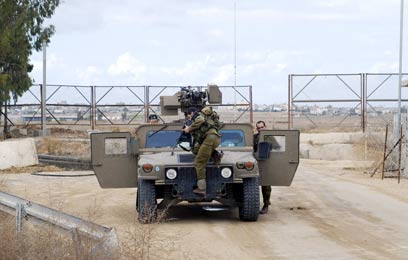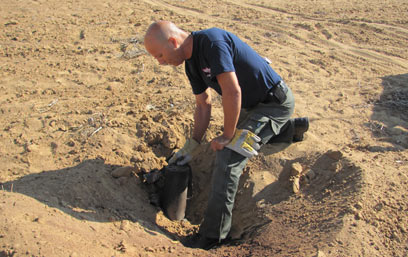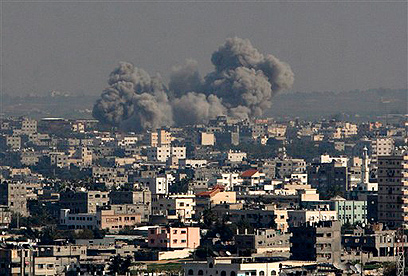
Last Wednesday, Israel Defense Forces troops on the Gaza border heard the code-word on their radios alerting them to possible infiltration into Israeli territory. Combat units went on alert and the northern division commander in the Gaza Brigade, Colonel Ofer Levy, cut short a briefing and focused on managing the incident. He was informed that an IDF patrol spotted suspicious indications by the fence that may attest to infiltration by terrorists, or job-seekers.
In such cases, the speed of the IDF's response is critical. Every minute of delay may exact human life. Only hundreds of yards separate the border fence and tens of thousands of Israelis who live and work east of it, in 34 communities. Under such circumstances, any person who manages to cross the fence, above or below ground, may become a suicide bomber. Alternately, a group of terrorists may aim to abduct another soldier, in order to boost Hamas' bargaining power.

Troops near Gaza fence (Photo: AFP)
In such cases, the division commander must quickly decide whether to continue routine operations, or alternately, order civilians to stay indoors and pour forces to the area. While making the decision he must take into account the economic and emotional price such situation exacts from residents. In the above case, the indications on the ground were not unequivocal, prompting the division commander to hold off his decision until his senior tracker examined the signs. After a few tense moments, the Bedouin tracker ruled that no infiltration took place. Fifteen minutes passed from the initial alert to the order to return to routine.
Daily security incidents
This, more or less, is what the "lull" prevalent in the Strip since Operation Cast Lead looks like. Warnings of infiltration attempts are a virtually daily affair. Almost every week, rockets or mortar shells land in Israeli communities. IDF forces deployed along the Strip sustain sniper fire, anti-tank rockets, RPG missiles, and roadside bombs. Since the beginning of 2010, more than 70 mortar shells and a similar number of rockets were fired into Israel, including two long-range Grad rockets fired at Ashkelon. During the same period, more than 100 "fence incidents" of all types took place.The Strip's northern sector is where the clashes are most intensive, because of the proximity of relatively crowded Israeli communities east of the fence and the 1.2 million Palestinians in Gaza city and nearby refugee camps. Thousands of these Palestinians are active in "rogue" terror groups that do not honor the de facto ceasefire between Hamas and Israel.
Ever since Operation Cast Lead, the number of Israeli casualties in the area is relatively low. The real estate market in Sderot and in area kibbutzim is peaking, and the Sapir College is teeming with students. However, the residents still live under the shadow of a tangible threat, and the IDF needs to deploy its best field units to this sector. One of the most important reasons for the relative security enjoyed by Israeli residents in the area is that the IDF draws and stops the most potentially lethal attacks.

Rockets keep landing (Photo: Ronit Minker)
The IDF's preventative defensive operations are mostly managed in a kilometer-wide buffer zone extending from the fence to the outskirts of nearby Palestinian neighborhoods. Within this area, the IDF defined a 300-meter strip as a "special security zone" (SSZ) where the IDF prevents the movement of Palestinians even if they are not armed. The IDF cleared this area of almost all vegetation and structures, which allows for strict surveillance, day and night, via cameras installed on high posts in Israeli territory.
Spot-and-fire
Female lookouts operate the cameras remotely, yet their job is not only limited to scanning the area. When they spot gunmen or people who appear to be carrying explosive devices inside the SSZ, they are allowed to open fire through special devices positioned on the Israeli side of the fence. These unmanned positions feature heavy machineguns operated remotely.In addition, the SSZ and areas deeper into Gaza are scanned by operational forces deployed at dominating positions within Israel, near the fence. These combatants are the ones who aim to create contact with terrorists, in line with intelligence information or based on the guidance of the female lookouts. At times, these troops cross into the Palestinian area in order to uncover roadside bombs. Such operations have developed into all-out battles in some cases and left several commanders and soldiers dead.
In the kilometer-wide strip, beyond the SSZ, the IDF allows Palestinian presence for the purpose of construction and agriculture. However, when gunmen or suspicious activities are spotted, heavy fire is directed at the area, usually through tanks and mortars. In some cases, gunships or drones are dispatches in order to help the forces spot gunmen.
This defensive deployment has two limits: One stems from conditions of fog (mostly in winter) that limit the surveillance and prevent remote fire. The second, more dangerous limit is the tunnels dug by the Palestinians. To this day, the IDF does not have a solid method or good detectors that would quickly enable it to uncover tunnels, such as the one used by Gilad Shalit's abductors. The most effective means against these tunnels is human intelligence gathered by Shin Bet agents inside the Strip, as well as the information provided by the IDF's electronic surveillance. The uncovered tunnels are usually bombed by the Air Force every time the Palestinian fire rockets or mortar shells.
The rocket threat
Through this modus operandi, the IDF avoids what may be globally perceived as provocation, while at the same time maintaining the deterrence against Hamas achieved during Operation Cast Lead. In this context we should note that Hamas is also improving its abilities to uncover collaborators with Israel, and has also developed very creative ways to hide the digging of tunnels. However, overall the IDF's deployment is achieving its aims on the ground. The combination of a physical buffer zone, intelligence information, and Air Force activity enable the army to protect residents and soldiers from attacks.The unresolved problem that bothers area residents and Israel's top brass is the rocket and mortar fire. Despite the efforts invested by Israel in curbing arms smuggling, currently there are some 5,000 rockets of all types in the Strip. Most of them are Qassams and Grads, and a few dozen are heavy Fajr 5 rockets (weighing some 160 pounds and possessing a range of more than 40 miles.) Most of this arsenal is held by Hamas, but significant quantities are also possessed by Islamic Jihad, which receives its orders, funding and arms from Iran. Some arms are also held by the Popular Resistance Committees and the al-Aqsa Martyrs that operate with Hezbollah's patronage and assistance.
Hamas, which at this time is not interested in confrontation with Israel, ensures for the time being to adhere to the "rules of the game" and prevents its members from firing rockets at Israel. The organization is attentive to the population's distress and requires a period of calm in order to rehabilitate and build up its power ahead of the next round; for that reason, Hamas also forbids other groups from firing. However, it's not always successful. On occasion, a cell belonging to Islamic Jihad or to the Popular Resistance Committees fires a rocket or two, or some mortar shells, to make it clear that the armed struggle against Israel is alive and well.
On occasion, as was the case in April this year, when the objective was to torpedo peace talks between Israel and the Palestinian Authority, Hamas' operational force turned a blind eye to rogue groups, enabling them to fire. Hamas itself sent some activists to Sinai to fire Grads at Eilat without leaving "fingerprints." Yet for the time being, the rocket fire from the Strip is no more than a trickle, which is bothersome and at times dangerous, but does not constitute a genuine threat. This will not be the case should real fighting break out.
Ground incursion only choice
Even though Hamas is deterred and is interested in a continued lull, the Strip may ignite at any moment – either because Hamas abducts another Israeli, or because the northern front will see a flare-up and Hamas, just like other groups, will be pressed by Iran and Hezbollah to play a role. Under such circumstances, we should expect to see rocket barrages from the Strip landing not only in Ashkelon, Beersheba and other southern communities, but also at the outskirts of central Israel communities. Meanwhile, western Negev communities near the fence will sustain mortar shell barrages.In such case, Israel would not be able to do with air strikes and active defense to be provided by the Iron Dome anti-rocket system. It has already been proven that "hunting" rockets from the air is not overly effective when they are fired from underground launching pads or from within vegetation. The Iron Dome system, which is still at early stages, would also not be able to intercept large barrages fired at targets across Israel.

Operation Cast Lead (Photo: AP)
In order for this system to constitute an effective response to rocket attacks on civilian communities, the IDF needs dozens of batteries. For the time being, there is no budget for this. Meanwhile, the IDF prefers to deploy the operational batteries at Air Force airfields and strategic sites such as power plants and the Ashdod port, in order to enable the IDF to operate quickly and in full force and to prevent economic paralysis.
Hence, Israel has no choice. In order to paralyze the rocket fire from the Strip, the IDF would have to embark on a major ground incursion into Gaza. Such operation would be much tougher and more complicated than what IDF troops experienced in Operation Cast Lead. This time, the IDF will likely not be able to drastically curb the number of rocket attacks within days, as was the case in Cast Lead. The reason is that Hamas and other terror groups drew lessons, among other things from the Goldstone Report, and are preparing accordingly.
What's the objective?
Despite this, IDF officials are convinced that the army can curb rocket fire from Gaza, even while the military is actively engaged on the northern front. The IDF's readiness and the number of available forces allow the army to execute a combined ground-air assault deep into Gaza, and possibly throughout the Strip.The question is what would the objective of such operation be – greatly minimizing the rocket fire, destroying Hamas' physical infrastructure and ending up with a similar "arrangement" as the one following Cast Lead, or eliminating the Hamas regime in order to fundamentally change the strategic and political situation in the Palestinian-Israeli theater? The latter objective is viable, according to senior IDF officials, yet it would require a long stay – of six months or more - of large Israeli forces and Shin Bet agents in the Strip, with all the casualties and immense economic price this would entail.
The political leadership will have to choose one of two possible strategic objectives for the campaign. The fact that the Olmert government was unable to agree – before and during Operation Cast Lead – on the strategic objective prompted a standstill and humiliation in the last days of the operation. It's unclear what the Netanyahu government would do.
What is clear, however, is that today too, as was the case during Cast Lead, the security establishment recommends a limited target: Go in, paralyze most of the rockets, exact a heavy price from the human and physical infrastructure of Hamas and other groups, and then get out.
Such operation would facilitate another long period of lull on the Gaza front, until the next round. Defense officials say that we should not expect more than that.
- Follow Ynetnews on Facebook















